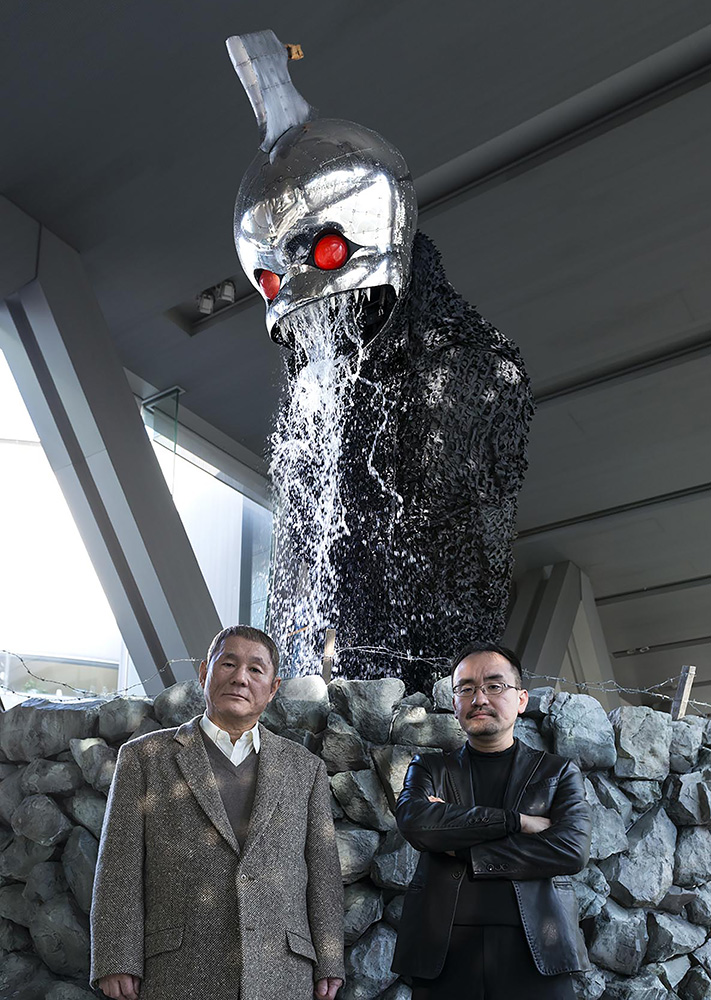(1/2) ANGER from the Bottom [2013]
Rebelion of the Earth
As a feature of special TV program Takeshi Art Beat, which was broadcasted on January of 2013, Beat Takeshi (a comedian and a movie director) visited Kyoto University of the Arts and ULTRA FACTORY and experienced the art classes there in the autumn of 2012.
In ULTRA FACTORY, Beat Takeshi and Kenji Yanobe embarked on a collaborative project. Beat Takeshi offered an idea and discussed it with Yanobe, and Yanobe and his students who joined the project made the work together.
Takeshi’s idea was to make a sculpture of monster which comes out from an old unused well. He got this idea from the experience of visiting Japan Pavillion at Venice Biennale. At the pavillion, he saw a piloti style opening connecting the piloti and the hall and the opening reminded him of the old unused wells which were seen anywhere in downtown of Tokyo in his childhood. Since then, he has developed an idea of making an art work using an old unused well as a motif.
Traditionally, the wells had been loci of cultural and religious significance. The wells served as meeting place of local people, and the water from wells was regarded as a blessing of nature. Suiryujin (God of dragon in water) had been believed to live in the wells and Oiwa-san, a female ghost comes out from a well in Yotsuya Kaidan (Yotsuta Ghost Story). All these daily practices and stories were lost with the closure of well. As water and sewer services were fully equipped in the high economic growth period, the wells became useless and polluted with garbage and industrial waste, and finally closed.
Takeshi and Yanobe decided to make a sculpture of angry monster which used to live in the well as a god. The sculpture was meant to ironically express the current human conditions, exposed to fury of nature because of the environmental pollution. Takeshi proposed the idea that the ax is stuck on the head of monster. The idea was based on Takeshi’s gag, a parody of an Aesop’s Fable The Honest Woodman; in Takeshi’s gag, a mean woodman, imitating the honest woodman, threw his ax into the lake and the ax stuck into the god’s head.
Yanobe made a model of monster with an ax stuck on its head. The monster was designed to rise up from the bottom of well, spitting out water from its mouth. The monster has a head like a skull and its body is covered with scales. The chin was operated to spit water with a mechanism which is close to that of Bunraku Ningyo (Japanese puppet theatre).
The sculptural work, entitled as ANGER from the Bottom was a exquisite combination of Yanobe’s artistic skill and Takeshi’s idea; Yanobe revived the mechanism of traditional Bunraku Ningyo from Edo Period and Takeshi, an skilled stage performer conceived an idea with a well organized story. Both of them got their ideas from the tradition of entertainments, local community and religious faith in Japanese society and expressed in the form of contemporary art.
To gain rust resistant effect and bright surface, Yanobe chose stainless steel as a material for the body of monster. As stainless steel is heavier than aluminum, he made a mechanism of hydraulic system to raise the body of monster, which has a total length of 8m and spit the water contained in the chin when the head is raised to the top. ANGER from the Bottom is one of the biggest works of Yanobe in terms of length, weight and mechanism. He made a model of old well from the stones of Fukushima. This process was unnoticed but had a symbolic meaning.
ANGER from the Bottom was exhibited at the Museum of Contemporary Art Tokyo for the first time. The project, started from a feature of TV program, gathered much attention and broadcasted widely.
